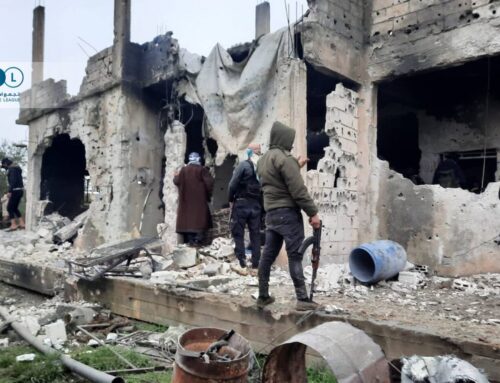Rebels leave as mountain town chooses surrender over ‘death by bombardment,’ says opposition negotiator
Rebel fighters and their families marched through Serghaya on Monday […]
21 February 2017
Rebel fighters and their families marched through Serghaya on Monday toward the line of buses waiting for them at the town’s border.
Shortly after noon, a convoy of eight of the regime’s green buses filled with 200 passengers left Serghaya, located in the a-Zabadani mountains along the Lebanese border. The buses departed for opposition-held Idlib province.
Only a handful of Serghaya’s 20,000 residents chose to leave the town, fearing regime bombardment there and miserable conditions in Idlib displacement camps.
For almost two years, regime and Hezbollah forces have blockaded Serghaya, preventing the entry of medicine and fuel while cutting off access to farmland. However, Serghaya has mostly avoided regime shelling.
The town was controlled, until Monday, by a small contingent of Free Syrian Army fighters, as well as a local council.

Rebels evacuated Serghaya as part of the most recent rebel-regime settlement in Outer Damascus after two weeks of Russian-brokered talks, Firas al-Ghadban, a local physician who acted as an opposition negotiator, tells Syria Direct’s Bahira al-Zarier.
For the regime, the settlement means the return of Serghaya and surrounding towns on the Lebanese border to government control. For town residents, the reconciliation brings hope that regime forces will release detained residents and lift their blockade of the town.
“The most important thing,” says al-Ghadban, as rebels boarded the buses on Monday, “is that the regime doesn’t bombard Serghaya.”
Q: What sparked the decision to accept a reconciliation agreement with the regime? When did your negotiations with the regime begin?
Negotiations began two months ago, and the agreement was brokered by Russia.
The residents of Serghaya were threatened with regime bombardment if they did not reconcile and evacuate the rebel fighters. We had two choices: we could face death by bombardment or we could reconcile. We accepted the settlement to keep the blood of Serghaya’s women and children from being spilt.
Q: Aside from the evacuation of the rebels, what are the terms of the agreement between the regime and the town of Serghaya?
The agreement allows for any town residents to leave Serghaya if they wish. They will be guaranteed protection by the regime on the journey to Idlib province. All prisoners detained [by the regime] since 2013 will be released.
There are about 5,000 people in Serghaya who have defected from the military or dodged the draft. They will have a six-month grace period in order to resolve their situation with the military. Then, they will be allowed to form an armed security force tasked with protecting Serghaya.
Displaced residents in the town of Serghaya are also covered in the terms of the agreement.
[Ed.: Serghaya is home to thousands of displaced residents from towns in the surrounding a-Zabadani mountains. Al-Ghadban estimated that up to 20,000 residents, many from the nearby town of a-Zabadani, currently live in Serghaya.]Rebels leave the town of Serghaya. Video courtesy of Central War Media.
Q: The 200 people who left Serghaya for Idlib were almost exclusively rebel fighters and their families. Why do you think so few residents of Serghaya, a town with an estimated 20,000 residents, opted to leave the town?
We accepted this agreement because of the threat of regime bombardment. It’s frightening to think of what sort of life Serghaya’s residents might lead in the [displacement] camps of Idlib, which is constantly shelled. We’ve been raising awareness among residents [about the conditions in Idlib] so that they stay in Serghaya.
In Serghaya, we’re scared of being shelled. If we had fled to Idlib, we’d be scared of being shelled. So, we chose to stay.
Q: What does the rebel-regime settlement mean for the residents who are staying in Serghaya?
The most important thing is that the regime doesn’t bombard Serghaya and that they lift the blockade on the town, allowing for humanitarian organizations to enter.
[Ed.: The last time Serghaya’s residents received humanitarian assistance was July 2016 when a UN aid convoy entered the town.]Hezbollah forces blockade the town from the north and west, and the regime from the east and south.
It is also important that the regime follows through on all clauses of the agreement, particularly the release of detained residents.







